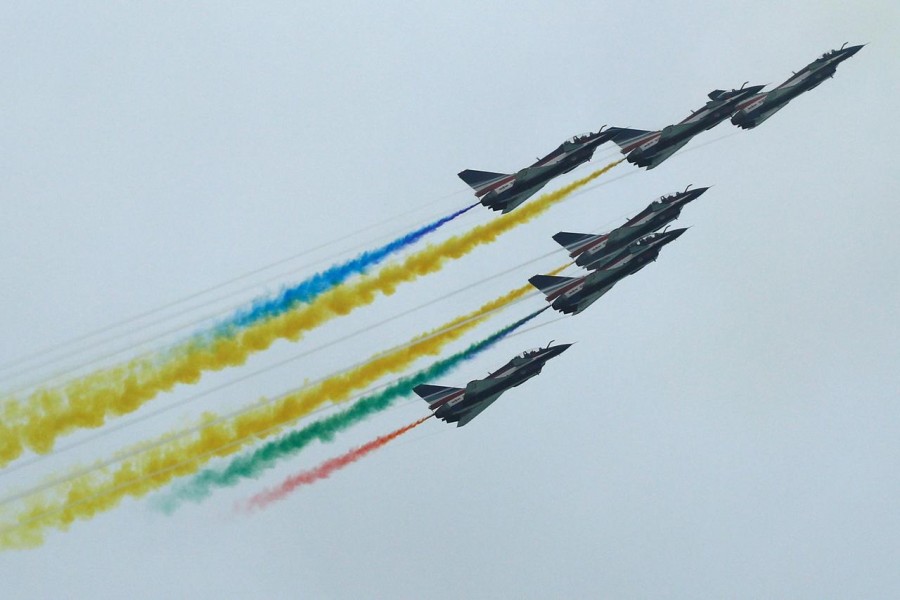Organisers scrambled on Sunday to shore up the Singapore Airshow, which is going ahead under a cloud of health and economic concerns after dozens of exhibitors pulled out of Asia’s largest aerospace gathering due to coronavirus fears.
Few deals are expected at the biennial event, where health warnings have triggered new safety measures and cast a shadow over airline profits and demand for airplanes.
After years in which the airline industry has become used to weathering external shocks from epidemics to security threats, one of the industry’s leading showcases has itself been thrust into the spotlight as the number of deaths in mainland China, where the virus first erupted, rose above 800.
More than 70 exhibitors have pulled out of the Feb 11-16 show, usually a magnet for planemakers, suppliers and arms buyers due to strong demand for civil jetliners coupled with weapons demand fed by regional power rivalries.
“Based on our assessment of the situation today...we have decided to proceed with the trade and public days,” said Tan Kong Hwee, assistant managing director of Singapore’s Economic Development Board.
Organisers advised trade visitors to avoid shaking hands and to choose alternative forms of greeting such as bowing or waving hands. The number of public tickets available will be halved, Reuters reported.
Singapore on Friday raised its coronavirus alert level and reported more cases not linked to previous infections or travel to China. It advised non-essential large-scale events should be deferred or canceled, but said the air show would go ahead.
Organisers said they were expecting more than 930 companies from 45 countries and 45,000 trade attendees - down from last time.
In 2018, there were 54,000 trade attendees and 1,062 firms as the event contributed S$343 million ($247 million) to the local economy through hotels and other spending, according to organisers. The show also attracts high-level foreign delegations.
Five delegates privately expressed surprise the show was going ahead, but organisers insisted they had a responsibility to those who wished to attend.
“It has grown to such stature and importance it is a very important part of the entire ecosystem of the global aviation industry,” said Leck Chet Lam, managing director of Experia Events, partly owned by ST Engneering and government agencies and which manages the show and exhibition site.
SUPERPOWER FLIGHT DISPLAY
This year’s depleted gathering comes against the backdrop of slowing passenger growth in Asia, down to 4.2 per cent in 2019 from 7 per cent in 2018 as economies cool their recent expansion, according to the Association of Asia Pacific Airlines.
“Already, there were signs of weakness in the cycle and then coronavirus comes along,” said Rob Morris, head consultant at UK-based Ascend by Cirium.
“Given how much bigger China is today as a part of the global economy and the global airline traffic, the potential for impact is clearly much greater than it was for SARS back in the 2000s,” Morris said, referring to a 2002/2003 viral outbreak.
The crisis further complicates a challenging picture caused by the 11-month-old grounding of Boeing’s 737 MAX, he added. Both Boeing and Airbus have reduced attendance at the show.
Air freight, which feeds a significant proportion of Asian airline revenues, has had its weakest performance since the financial crisis in 2009 amid US-China trade tensions.
This week’s show will still feature a rare head-to-head, superpower fighter display from the United States and China.
The United States will fly the F-35B a month after it gave approval for Singapore to purchase up to 12 of the jets.
Manufacturer Lockheed Martin Corp has, however, pulled out of show and the Pentagon has reduced its participation.
The announcement of the first appearance of China’s People’s Liberation Army Air Force aerobatics team, Ba Yi, with J-10 fighters was a last-minute surprise, given Singapore’s travel restrictions due to the virus that led 10 Chinese exhibitors to pull out from the show.


